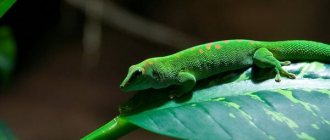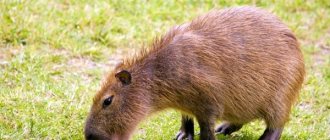Chameleons are a large family from the order of scaly reptiles. Since these reptiles spend most of their lives on the branches of trees and shrubs, they are often called tree lizards. Unpretentious and phlegmatic reptiles tolerate captivity well, so they are suitable for keeping as pets.
Everyone knows that a chameleon changes color, but this is not the only interesting feature of the animal.
Habitats
There are eighty species of chameleon south of the Sahara, which share tropical Africa and Madagascar. Four or five species inhabit India, Arabia, Southeast Asia and the Mediterranean coast of Africa. Individual specimens are found in southern Spain.
Long ago, during the heyday of the Secondary Era of reptiles, chameleons as large as cows may have existed. But those glorious days have passed, and today the fickle animal is content with an average size of 20-30 centimeters. As in many cases, extremes remain in Madagascar: there are eighty-centimeter giants and extravagant dwarfs who can easily fit four people in a matchbox.
The emergence of new species.
The chameleon family is attractive not only for its mimicry, but also for its constant renewal. In 2009, 5 new species of these lizards were discovered.
Important! The distribution area of new animals of this genus is so small that they are threatened with complete extinction.
1 species in Madagascar is Furcifer Timoni Glaw , distinguished by its bright green color.
The other 4 were discovered in Africa, have a sharply limited range, and therefore remained undiscovered until recently. These are representatives such as Bradypodion ngomeense (living in just one single relict forest in KwaZulu-Natal), Kinyongia vanheygeni and Kinyongia magomberae.
Nutrition
What does a chameleon eat? Like many others
lizards, chameleons are predators. Their diet is based on various large insects (crickets, butterflies, beetles), other small lizards, and sometimes even snakes. Large chameleons can hunt birds, rodents and other small animals. However, some chameleons will not mind eating leaves and fruits; they especially love tangerines and oranges; they can eat cherries, cherries and grapes.
Read on for more details on chameleon hunting methods.
What do chameleons eat in the wild?
The main diet of lizards consists of a variety of insects and their larvae. Representatives of giant species often eat small rodents, reptiles and even birds.
Chameleons are predators, but can also eat plant foods. They eat soft vegetables, fruits, and plant leaves. In this way, animals replenish the reserves of moisture and vitamins in the body.
Arboreal reptiles are not voracious and are able to survive on small amounts of food.
Description, structure, characteristics
What does a chameleon look like? All these people are covered with skin with dense, pearl-like granules interspersed with tubercles, thickenings and growths of the most bizarre pattern. There are chameleons who dress in a tournament knight's helmet, or in a helmet, or decorate their faces with the sharp nose of Pinocchio. Others encircle their eye sockets with rows of pearl necklaces like “hippie” beauties, others make up themselves as miniature ones.
rhinoceroses - with two, three and even four horns!
Within the reptile family, chameleons have a reputation
monkeys for their love of climbing trees. For this purpose, nature divided their five-toed paws into two groups of two and three fingers, covered with horny scales and ending in claws. Everything is complemented by a flexible tail - the chameleon quickly wraps it in a spiral around the nearest stop.
Chameleon is the king of camouflage. He is not at all interested in showing himself either to the prey he hunts or to the predators who consider him their delicacy - snakes and some large birds. The chameleon is the undisputed champion of stillness. It is capable of freezing in the foliage for several days and sometimes weeks. Honestly, a chameleon could work as a chimera in the Gothic cathedrals of Europe. But the chameleon has other goals: it needs to lull its vigilance.
For this subject, our hero uses the invisibility technique in front and profile. From the front it looks completely flat. From the side, it is indistinguishable from the surrounding background - not because it has the ability to change its color at will, as many mistakenly believe, but because of the structural features of its skin, which allows it to dissolve in the colors of the forest.
What to feed?
The diet of young chameleons consists of newborn or one-week-old crickets, which are sprinkled with a mixture of powder consisting of calcium phosphate and vitamins for reptiles, taken in the same proportion. They are fed 2 times a day; there should be enough food.
To prevent young chameleons from becoming dehydrated (which they are susceptible to), mist the terrarium with water twice or thrice a day.
Adults are fed from a feeder or tweezers with large crickets, tropical cockroaches, and are offered fruits and the fleshy leaves of some indoor plants, which they eat with pleasure.
A low plastic or glass container is suitable for the feeder. Its inner walls are lubricated with vegetable oil to prevent insects from scattering.
Chameleons do not know how to drink from a container , so if you cannot make a pump, try teaching them to drink from a syringe with a blunt needle or from a pipette. If this does not work, squirt small doses of water into the chameleons’ mouths when they open it.
These lizards, in addition to water, can drink juices. Prepare a honey solution for them, which the animals will also like.
If you follow the recommendations listed above, the chameleon will live with you for at least four years and delight the owner and his family throughout this time with its charming appearance and funny habits.
How does a chameleon change color?
Let's look at this mysterious skin in cross-section. Beneath the transparent epidermis of the chameleon lies a four-layered dermis: two stacked layers of crystalline cells, one of which reflects the blue part of the light spectrum, and the other the violet; they are covered, like a ham sandwich, with a top layer of pigmented yellow cells and a deep layer of dark brown cells. This structure allows for countless color combinations with the smallest intermediate shades - depending on whether the cells are contracting or increasing in size. Thus, a screen is created for the violet and then for the blue part of the spectrum, and the entire surface shimmers with a thousand highlights.
Protected by invisibility from all sides, the chameleon reveals itself only while moving. Knowing about this vice, he manages to move his body so as to... appear motionless, breaking all records for slowness of movements. Next to him, the Burgundy snail looks like a racing car. The chameleon breaks any movement into a thousand elusive sub-movements, capturing them at every millimeter, as if in slow motion.
At first, the front paw moves slightly - it hovers, as if feeling the air, then, in the same rhythm, it lowers to the chosen place, after which the claws firmly dig into the tree. Then it’s the turn of the hind leg and so on. Only when all four limbs are securely secured does the chameleon allow itself to move its tail to a new position.
At the same time, the chameleon sways from side to side, it seems as if it is swaying in one place. But what a contrast with the lightning speed of the subsequent operation - throwing out a long tongue towards the intended victim: a fly, a grasshopper, a dragonfly or a bird! Of course, with this method of hunting, you must sneak up on the prey so as to be face-to-face with it. The victim sees a chameleon. And doesn't notice him. A slight sway gives the impression of a twig being swayed by the breeze. No, the victim does not even listen, believing that there is no danger on the horizon. And when she realizes it, it’s already too late.
Hunting
Thanks to their long, powerful tongue and eyes that rotate in different directions, chameleons are quite successful hunters. Noticing the victim, they direct both eyes at it and “shoot” their tongue in its direction.
The tip of the tongue takes the shape of a cup, and the caught insect is sent straight into the mouth of this unusual lizard. Hunting is also helped by the fact that the tongue acts like a suction cup. This deprives the victim of any chance of salvation. The capture takes a tenth of a second.
The tongue can hold food weighing up to 50 grams, and it can also take a position in which it becomes possible to grab an insect located on the opposite side of the leaf.
Chameleons wait for prey very patiently, sitting motionless for hours. But all this does not mean that they are lazy and clumsy: if necessary, chameleons can not only run fast, but also jump through trees.
Interesting! Chameleons have good vision for reptiles and can see even a small insect from a distance of up to 10 meters.
Chameleons have unusual vision: their eyes can rotate independently of each other 360 degrees, which allows them to immediately see the victim and prevent danger to themselves
How does a chameleon hunt?
Here in the Congolese forest there is a large praying mantis sitting on a tree. He goes to the toilet, not caring at all that there is a strange lump frozen next door: after all, they are separated by a good thirty centimeters.
For some time, the chameleon maintains the pose of a stone statue. But suddenly the praying mantis disappears. It seems to you that the reptile has not moved. Only the movements of the jaws now suggest that the insect is somehow
evaporated and rematerialized in the chameleon's mouth. Magic, and that's all!
The praying mantis fell victim to a false sense of security. How does he know that the enemy belongs to the worm-tongued suborder and has magnificent weapons that strike like Toledo steel? Mantis hasn't read Brem.
The shooting tongue of a chameleon is a miracle of mobility. The length of a chameleon's tongue is often equal to the size of its body, so that a fifty-centimeter chameleon with its tongue hanging out suddenly grows up to a meter in length. But, as we know, the point is not in size. The speed of the back-and-forth movement of the chameleon tongue has no equal in the animal world. It has to be seen to be believed. But how to see if the eye does not have time to catch the movement?
The tip of our hero's tongue looks like an arrow with a rubber suction cup, which is sold in a children's toy set. It is moistened with a special sticky substance. In a calm state, the tongue rests in the mouth, curled around a bony spur, but at the request of the owner, it flies out from there, pushed out by a sharp contraction of the ring-shaped muscles, and, having struck the prey, returns with it to the starting point. The victim's only chance of keeping his skin is to wet said skin with water.
This feature was discovered completely by accident in the laboratory. One day, in the plate where the food was placed, there was some water left, into which the worm landed. The chameleon, as usual, shot at him from a distance of 15 centimeters. The tongue came back empty! The puzzled chameleon crawled close and repeated the maneuver from two centimeters away. Same result! After a number of fruitless attempts, the chameleon had to become like a shooter who rests his nose on the target. But this time the tongue only licked the tasty prey and returned unsalted slurping. The chameleon was forced to give up his pretense and grab the worm with his mouth, like everyone else does.
The challenges of shooting at a distance require the chameleon to have a developed sense of distance. You can stretch your tongue 14 centimeters as much as you like and still be left without lunch, since the prey is fifteen centimeters away. And the lost victim will not wait until you stick your tongue out at her again. Fortunately, our hero is equipped with an excellent telemetric device, which he has the right to be proud of as a curiosity: these are his eyes. In a sense, they even surpass language in perfection.
Description and natural habitat
The chameleon belongs to the family of lizards that lead a predominantly arboreal lifestyle. There are many different species, but most have a body length of about 25-35 cm, although there are also very small ones (2.9-6 cm), and the largest individuals have sizes up to 55-65 and even 80 cm. Weight from 30 to 1500 gr.
The head has the shape of a helmet with a high nape, scallops, tubercles, and sometimes horns. Most often males are decorated with these formations; in females they are in their infancy.
The long limbs end in modified fingers, fused in groups of 2 or 3. They look like claws and make it easier for the Chameleon to climb tree trunks.
Photo gallery of Chameleons:
The tail of almost all varieties is long, it is wide at the base and narrow towards the tip, has the ability to curl into a ring, the lizard can also wrap it around branches and a trunk.
These tree lizards have very unusual vision. The eyelids are always drooping and glued together, but they have holes for the pupils. Moreover, they can move in complete disagreement with each other when hunting for insects and provide a circular view, but before the final throw, both the right and left converge on the object.
When tracking prey, the Chameleon freezes for a long time on a tree, merging with the bark and foliage, but its pupils are constantly in motion. It grabs its prey with a long tongue with a kind of suction cup on the tip, and the lizard throws it out so quickly that this movement is difficult to evaluate (in 0.05 seconds). In one second, the predator is able to catch and eat two bugs.
In a calm state, the tongue is curled in the mouth and fixed with the help of a bony outgrowth on the lower jaw. If the caught insect is too large and heavy, the Chameleon cannot hold it with its tongue. He remembers the failure and subsequently catches such a beetle in his mouth.
But the most amazing feature of the Chameleon is the ability to change color and body pattern. This is due to the special structure of the skin and the content of chromatophores in it. These special cells contain granular inclusions of different color pigments - black, brown, red, yellow.
When the nerve endings contract, the grains are redistributed, localizing the largest concentration of light pigment in the center of the cell. Then the body color becomes white or yellowish. If dark fibers accumulate at the point, the lizard's skin turns black or gray. With different combinations of pigment inclusions, the outer cover of the Chameleon blooms in a variety of shades. In this case, green tones arise due to the refraction of sunlight, since the scales also contain special guanine crystals.
This special structure of the skin allows the tree lizard to rapidly change color over the entire surface of the body or in its individual zones. The irritant in this case is changes in the external environment (heat, cold, bright light, high or low humidity) and changes in the internal state (feelings of hunger, thirst, fear or anger).
Chameleons are active during the day; at night they sleep and lose the ability to change color. Their cover becomes very light and noticeable to predatory animals.
It is incorrect to assume that the main purpose of this ability is mimicry. The main thing for which the Chameleon uses different colors is to communicate with its relatives and other animals, for example, demonstrating a threat to a rival or an attacking predator.
The largest population of Chameleons lives on the African mainland and Madagascar, with smaller numbers in northern African regions, southern European parts, the East, India, Sri Lanka, Hawaii, and some North American states such as California and Florida.
These are the indigenous inhabitants of the forest tropics, savannas, and sometimes - inhabitants of deserts and steppes. But there are very few terrestrial species.
The chameleon is a very ancient lizard. The oldest fossil specimen found in the European part of the Earth is about 26 million years old. Most likely, the population of this family previously inhabited the entire globe, but its center was in Madagascar.
The mating season in nature occurs in October-November for most species. Females lay up to 50 eggs per season, the incubation of which takes a very long time (up to 9 months or longer). Some species of Chameleon are ovoviviparous. In this case, the cubs are not capable of independent life for a long time and live on the mother’s back. But most often, parents, having put the clutch aside, forget about it.
They usually lead a solitary lifestyle, uniting in pairs only during the mating season. But sometimes lizards gather in groups during the daytime, sit together on tree trunks and hunt for insects. Only a few species live in harems.
In nature, the lifespan of this species is 5-10 years, in captivity it is usually longer, up to 7-15.
Chameleon eyes
It cannot be said that a chameleon has a lively view of things. He has no look at all. Its impressive eyeballs are covered with a peculiar shell of the same texture as the rest of the skin; only in the center, opposite the pupil, a small hole is left. Why? Is a chameleon afraid that a fly will fly into its eye? No, the structure is subordinated to the same camouflage purposes. Is it worth dressing up as a leaf or even a tree if squirrels are ridiculously sticking out from there and your pupils are sparkling with the excitement of the hunt! Its structure, however, also has its own inconvenience: the chameleon is forced to look through a small hole, as if looking through a keyhole.
But he gets out of this situation with the usual ingenuity. Each eyepiece rotates wherever it pleases, without worrying about its partner. Thus, the left eye can follow a fly on the ceiling, and at the same time the right eye can watch for an ant walking on the floor. If you approach from the rear, the eyes will immediately turn to the back of the head, although the chameleon will not change the pose of the ceramic figurine. Then he will drive you out of one eye and return it to watching the fly.
The lack of a single field of view forces our hero to rotate the balls all the time. Each pupil, like a radar, covers its own 180 degrees of the landscape. If something interesting is noticed while moving, the second eyepiece sights the object and accurately sets the distance to it using a telemetry device.
In order for us to understand the system, it is enough to be in the skin of a chameleon for a few minutes. Here you are frozen motionless on a tree branch, clinging to it with your four claws; your tail is curled around the stop, only your armored eyeballs moving.
Suddenly, through the keyhole, you spot an insect that had the imprudence to flutter when passing through the eyepiece. The second eye immediately captures the overall picture of the situation. The data is sent to a central computer, which quickly calculates it and renders a verdict on the nature and exact location of the victim. You sway smoothly from side to side, changing the angle of sight to finally refine the calculation. The ultra-precise sight mechanism sends a command to the firing device. Start. There's a fly in your mouth.
It is clear that, with such equipment as rotating eyepieces and a harpoon cannon, there is no need for the chameleon to change position. He can calmly remain on his branch, waiting until the next food item falls into the radar beam.
Care and maintenance
For these pets it is necessary to prepare a terrarium; it can be made from an old aquarium measuring at least 65x45x90 cm. It should be installed where the quietest place in the house is. These animals do not tolerate stress well and are frightened by loud sounds and sudden movements. In addition, the tank should be high and protected from cold and drafts - lizards are accustomed to living in trees and in hot climates.
Good ventilation of the home is very important; it prevents toxic poisoning of the pet and prevents parasites from developing in a hot and humid environment.
Ventilation is carried out due to convection air flows, and holes are usually made in the back or in the top cover to remove heated air, the bottom is at the bottom in front (about 3-4 cm).
Environmental parameters should be optimal - with high humidity (60-90%) and daytime temperature +26...+29 ºC (lower at night). To monitor them you will need a thermometer and a hygrometer.
Often a fog generator is installed in the tank, or you will have to very often spray all the vegetation and the Chameleon itself with a spray bottle.
The fog generator can be replaced with a drip irrigation device, which can be purchased at any gardening store.
An incandescent lamp should always be on during the day, simulating sunlight, and infrared lamps need not be turned off at all.
To heat the terrarium, use thermal mats, which can be found in pet salons. They can imitate grass or large fireplaces are placed on top.
Sand and other small fractions cannot be used to avoid the death of the pet - they will most likely be swallowed.
The dwelling should be filled with snags, grass and branches so that the lizard can safely climb on them. In addition, for the same purposes, you can plant vine-like plants and make special shelves.
A drip irrigation device or a small fountain will not only humidify the air, but also serve as a kind of drinking bowl. Chameleons do not drink water, but only lick off its droplets. But you can teach them to swallow liquid from a syringe (they love natural juices and honey infusions).
It is better to equip the terrarium with thermostats and air ionizers. An ultraviolet lamp is also necessary; it is turned on twice a week for a short time to prevent rickets in your pet.
Lifestyle
All chameleons are lazy and phlegmatic; they spend almost their entire lives sitting motionless on tree branches, waiting for potential prey, without changing their original position for hours or even days. However, in case of danger they can run very fast.
The only exception to their phlegmatic lifestyle is the mating season, when these lizards begin to show at least some activity. We will describe the very interesting mating traditions of chameleons in more detail later in the article.
The main feature is a change in skin color
The most unusual feature of the chameleon is the change in color of its skin. Initially, the leading opinion among scientists was that he was doing this for camouflage. However, recent research has proven that the animal communicates in this way .
Color changes depend on several factors:
- time of day;
- climate;
- emotional state and health of a particular lizard.
During the mating season, males spend a minimal amount of time transitioning from one color to another. However, in most cases, changing colors is an expression of irritation, fear or threat to a fellow animal.
Important! A chameleon has the ability to change the color of its entire body or only its individual parts.
Types, photos and names
Zoologists count 193 species of chameleons, which are grouped into 11 genera. We will describe the most interesting of them.
Panther chameleon
It is one of the most brightly colored representatives. While young individuals have gray skin, older panther chameleons can take on a variety of colors and shades, from turquoise, green to red. The average body length is 52 cm. Males are usually larger than females and have a brighter color. It got its name due to a series of oval spots that are located on its sides. It lives on the island of Madagascar and neighboring islands. Can live at home as an exotic pet.
Yemen chameleon
A fairly large chameleon, up to 60 cm long. Like panther chameleons, males are larger and more brightly colored. A characteristic feature of this type of chameleon is its high crest, located on the head; it grows up to 7-8 cm. In its color, attention is attracted by 3 yellow spots on the sides, each of which is decorated with an orange and brown stripe. Unlike other species, male Yemen chameleons are more aggressive, sometimes life-or-death clashes occur between them. They live in the mountains of Yemen and Saudi Arabia.
Comb chameleon
This species received its name due to the characteristic fan-shaped comb located on the back. On his head he has something like a helmet, decorated with bright blue scales. It has a gray, brown or black color, while females are green. The body length of the comb chameleon is 20-25 cm. It lives in West Africa.
Jackson's Chameleon
This bright green chameleon can change its color very quickly, turning blue or yellow. A true master of camouflage. It differs from other chameleons by the presence of three brown horns located on the nose and between the eyes. The body length of this species is 30 cm. It lives in the tropical forests of East Africa.
Desert chameleon
Found exclusively in the desert regions of Angola and Namibia, this chameleon is perfectly adapted to life in arid environments. It changes its colors not only to camouflage itself from enemies, but also to regulate body temperature. Body length is 16 cm.
Common chameleon
The most common representative of the extensive chameleon family. It lives over a wide geographical range: from the forests of Syria, India and Arabia to South Africa. It is up to 30 cm in length. Skin color can be mottled or solid, it is usually bright green, but can turn yellow and bright red (depending on need)
Giant chameleon
The giant chameleon living on the island of Madagascar is notable for the fact that it is the largest chameleon in the world. The length of its body reaches 68 cm. It has a brown body, strewn with yellow, green and red spots.
Features of behavior in the terrarium
Almost the entire life of most Chameleon species is spent in tropical forests among dense foliage. They sit calmly on branches for hours waiting for prey and seem motionless, and if they move, it is leisurely and slowly. But as soon as the insect gapes, a rapid movement of the tongue immediately follows and the prey ends up in the lizard’s mouth. They are also capable of moving very quickly, escaping from predators, because they change colors more often during fights or courtship, rather than through mimicry.
Chameleons descend to earth precisely for mating games, sometimes chasing prey. During this period, the lizard's behavior changes, and it is very interesting to watch courtship. Males dance, first freezing in place, and then begin to rotate their pupils and raise their paws one by one, swaying. This is how they attract females.
The Chameleon behaves similarly to natural behavior when kept at home, and observing it, if the terrarium is properly equipped, is very interesting.
In addition, most species have remarkable intelligence, become attached to household members, love to be picked up and stroked, can move around the house under supervision and happily “beg” for food.
Large Yemen and Leopard (Panther) Chameleons are usually kept at home; they are easy to care for. Common ones are acquired less often; although they are unpretentious and small, they reproduce with difficulty in captivity.
Reproduction
Only the time of love forces the chameleon to emerge from its usual state of rest. It cannot be said that the chameleon loses its head here either. No. Order and regularity come first. But still, apathy disappears somewhat from the chameleon, and it even happens that he starts a fight with an opponent. Males rise on their thin legs, puff out their chests, sniffle and try to impress with their volume. In addition, they dress up in their most flashy colors.
Females show much less enthusiasm, apparently knowing that their lord has rude manners, which are common among all lizards. Poets have nothing to do with scenes of chameleon love. Having fulfilled his duty, the male turns his eyepieces away from the beauty, again becoming interested only in insects. And it begins to swell. After some time, clusters of eggs become visible through its skin. The egg-laying period is a busy time. Where do you want the offspring to go while hanging on a tree branch? There is nothing left to do but make a heroic decision - to go down to earth.
The female, in the end, does just that under the indifferent gaze of the male, who seems to say: “Get out as best you can!” Breaking with a thousand-year-old tradition of caution, the female chameleon leaves the saving surface of the tree. She is completely defenseless, numerous enemies see her.
But the female is in no hurry. You don't start laying eggs with a bang. Pushed by an underlying sense of duty, this exemplary mother begins to dig a hole in order to preserve flesh from her flesh. It must be said that nature did not in any way prepare her for this difficult task. The female chameleon scrapes the ground with her front paws and pushes it away with her hind paws, using a fox terrier technique. The hole can reach a depth of 20 centimeters with a diameter of 10, which, given her poor professional training, takes her three full working days.
Chameleon eggs
Having completed digging, the female lays 30-40 eggs in a hole, which she covers with earth and camouflages (oh, this mania for secrecy!) with grass and leaves. Alas, motherhood undermines her last strength - trench work is beyond the capabilities of a creature accustomed to wielding only her tongue. Often she gives her soul to God a few days later, without waiting for a happy event - it comes only three months later, when little chameleons crawl out of their birth hole into the light.
It is no coincidence that the females of some South African species refuse earth-moving feats and prefer to carry their offspring within themselves until they are fully mature. The moment of delivery poses the same problem: how to keep newborns on a narrow branch? Females find a witty way out of this situation. The baby appears in a kind of bag, covered with a viscous substance, which immediately sticks to the branch. The newborn waits patiently (a chameleon has no patience) until the glue hardens, and then scrapes the hole in the hole with sharp claws.
membrane So he enters the world, moving his eyepieces and preparing his child’s tongue for the first sighting manipulations.
Possible problems
If the Chameleon is kept correctly and has decent living conditions, then its immunity will be at its best and diseases will be avoided. But the genetic factor also has an influence, so it is important to prevent inbreeding - crossing closely related individuals. The offspring in such pairs often do not live to see 3-4 months and have external abnormalities.
The most common diseases in Chameleons include colds caused by dehydration and rickets. In addition, owners also face eye diseases, gastrointestinal disorders, molting disorders, vitamin deficiencies, and helminthiases.
Signs of trouble are excessive lethargy of the lizard and pale color.
The root cause of most problems is stress. Therefore, if the Chameleon is still afraid of people, you should not abuse his patience. You should get to know your pet gradually, while feeding by hand or using tweezers.
In most cases, symptoms of diseases appear so late that it is not possible to save the animal or only an experienced herpetologist can help, who is very difficult to find in Russian veterinary clinics.
Therefore, it is important to maintain the necessary parameters of the Chameleon’s habitat and feed it with high-quality food. The most important thing is to stay hydrated. It manifests itself in sunken eyes and cheeks, drying out of the paws and tail, and visible bones and vertebrae. You should urgently increase the humidity in the terrarium and seal your pet with Regidron.
Keeping at home
A bouquet of original qualities has long prompted people to classify the chameleon as a pet. In the southern regions of Spain it is used as an indoor fly catcher.
At first, the animal taken into the house displays the temperament of a cantankerous reveler and often bites the hand that feeds it. But over time, relations improve. The chameleon gets used to its owner. Don’t think that he will fawn and climb onto your lap; It is better to avoid the tight grip of his claws. But this is truly a faithful comrade - taciturn and unpretentious.
What to do if a Yemeni chameleon bites?
The pet often bites its owners. This lizard's teeth are quite large and its jaws are powerful.
The bites cause significant pain, bleed for a long time and leave noticeable scars.
This is a natural defensive reaction until the pet is accustomed to being handled.
But even a tame animal can bite if it gets scared or feels a direct threat.
Unfortunately, the only way to definitely avoid being bitten is to not handle the chameleon. There's nothing you can do about it here.
The wounds themselves do not pose a danger to human health. However, it is recommended to treat with an antiseptic and apply a sterile bandage.
Breeding
Chameleons breed quite easily in captivity. And once the owner has mastered the nuances of proper care and maintenance of one reptile, if desired, he can begin breeding offspring by selecting a mate for his pet. The mating process in reptiles occurs on the very first day after the female is placed in the terrarium with the male. There are two main signs that fertilization has taken place and the reptile is pregnant: aggressive behavior of the female pet and a change in its color to darker, with large bright yellow spots over the entire surface of the body.
The gestation of small lizards in the mother’s stomach will last for a whole month or a little more. During this period, it is important to give the female a sufficient amount of liquid (some breeders even feed the reptile with a pipette). A week before the eggs appear, mommy becomes more restless and begins to carefully examine the bottom of her terrarium in search of a place suitable for laying eggs. You can make this task easier for her by placing a small container (40 by 30 centimeters is suitable) with wet vermiculite (at least 15 centimeters deep) in the exoterrarium. The female chameleon will be able to dig a tunnel in it, at the end of which she will lay her eggs.
As soon as the laying has taken place, the container must be placed in the incubator (carefully place the future babies at a distance of 1 centimeter from each other). When laying eggs, it is very important not to turn them over, but to place them on the same side with which the female laid them in the tunnel.
To increase the chances of giving birth to live chameleons, maintain the correct temperature in the incubator (28-29 degrees during the day and 20-22 degrees at night).
After 4-9 months, the offspring hatch into the world. Babies are placed in groups of 5-6 in small terrariums, and when they reach three months of age they are necessarily separated from each other (remember about the aggressive behavior of chameleons towards each other). The diet of the babies will not differ much from the diet of adult chameleons; you only need to add calcium supplements to prevent rickets.
In fact, caring for a pet chameleon is not difficult; it is enough to study the nuances of keeping these exotic beauties in captivity, decide what you will feed them and how to take care of their health and good mood. This must be done before you adopt your pet permanently. And then he will delight you with a good appetite, grooming, and, perhaps, offspring!











